- Know
about the key folk dances of Punjab, Jammu and Kashmir, Uttar Pradesh, Haryana,
Rajasthan, Bihar, Madhya Pradesh and Himachal Pradesh.
There are
several folk dances in north India. They are performed on social and religious
occasions to promote harmony and unity amidst people. This feature covers folk
dances of the states of Punjab, Kashmir, Uttar Pradesh, Madhya Pradesh, Bihar
and Rajasthan.
A. Punjab and Haryana
1. Bhangra
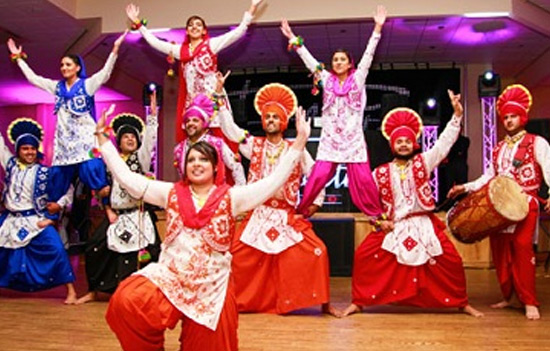
Bhangra
is one of the most colourful and popular folk dance of India, performed during
festive occasions like Baisakhi or during the harvest to celebrate rich harvest.
The dance is vigorously performed by colourfully attired Punjabi men with a
turban, handkerchiefs, kurta and lungi, as they dance with gay abandon to
different folk songs in Punjabi. Punjabis dance with full enthusiasm and high
spirits. Women too perform Bhangra that portrays farming along with acrobats,
while dancing and jumping around to the loud rhythmic music of a Dholak.
To see video of performance 5 minutes
2. Giddha
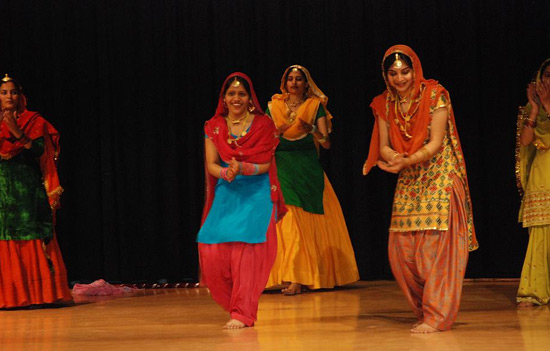
While
Giddha is primarily performed by women, Bhangra is mainly performed by men.
Young girls dance and clap singing folk songs relating to marriage, the new
bride or the young couple who is just married with some humour and satire,
pertaining to their married life.
Giddha is
performed during any social or religious occasion, signifying happiness and
harmony of life. The dancers are adorned with ornaments and salwar kamez in
varied colours.
Haryana
“Folk dances of Haryana: Most folk dances of Haryana surround the theme of harvest. Phag dance is performed in the month of
Phalgun. Saang is a popular folk
dance performed on the themes religious and folk tales by an even number of
people for five hours. Chhathi is
performed by women six days after the birth of a male child, followed by a
feast of boiled wheat and chanaa for all. Dhamal -performed only by men-is a dance form popular in the Gurgaon region, performed when the crop is harvest-ready. Ghoomar is a popular dance from the Western regions of Haryana in which women swirl and clap faster and faster as the tempo of the music increases.” Source
Indian Express
B. Jammu and Kashmir
In Kashmir
the dances signify the various spheres of life and is performed by girls
and boys on different occasions.
1. Rouf
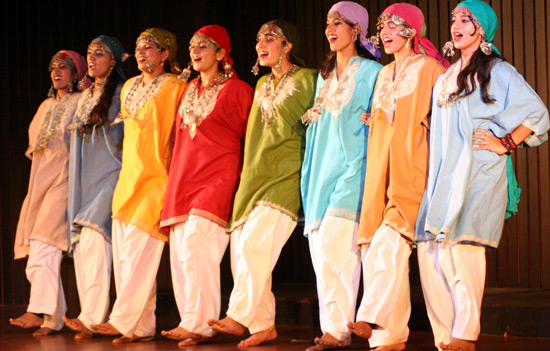
Rouf is a
folk dance exclusively performed by women during religious occasions like Eid
and Ramzan. While seeking divine intervention, the dancers pay homage to the
Almighty with the typical religious attitude and gratitude for the peaceful and
healthy living of everyone. The dancers move in simple and graceful steps,
while dancing together and facing each other.
To see video of performance 4.5 minutes
2. Bhand Pather
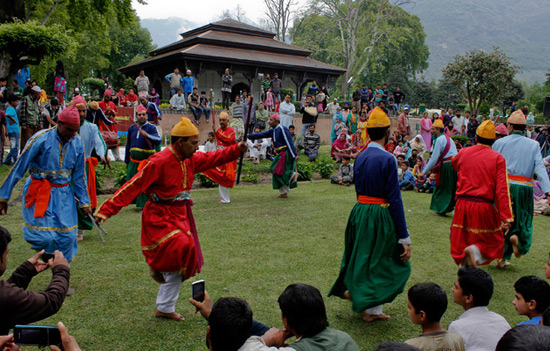
The dance
has a social significance, as it relates to different social customs,
traditions and the interpretation of episodes or stories related to society
with a touch of humour or satire attached to it. It is a dance with a playful
style, hence combines significance with entertainment. This is performed by
both men and women.
3. Hafiza
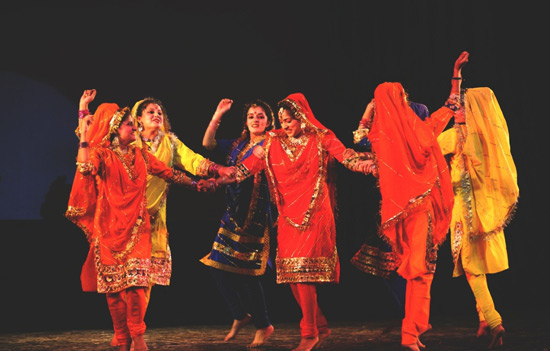
Hafiza is
performed by women during occasions like marriage with different movements and
style of dancing. The women are beautifully attired with colourful costumes and
silver jewellery which covers the head of the female dancers.
To see video of performance 6 minutes
4. Bhand Jashan and Bhand Nagma
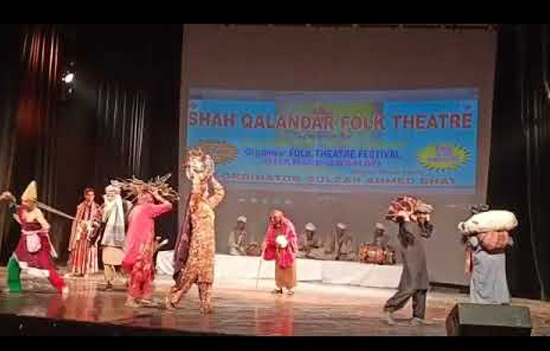
These are
traditional folk dances of Kashmir with a large group of dancers, maybe ten to
fifteen dancers, performed during festive occasions like the harvest season,
with songs referring to nature and life. There are boys too who attire as girls
to entertain the audience with the Hafiza style of dance.
5. Wuegi-Nachun
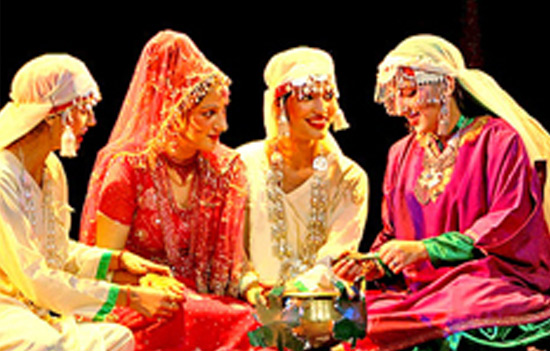
This is a
less popular dance of Kashmir, as it is performed after marriage, as the young
bride leaves for her new home. The dancers dance around the rangoli (colourful
decoration by powder or flowers) while seeking divine intervention for the
happy married life of the young couple.
6. Dogri Dance
To see video of performance 6.47 minutes
C. Uttar Pradesh
This state
of north India has a large variety of folk dances that has been prevailing for
centuries, maintaining its regional flavour and authenticity.
1. Nautanki
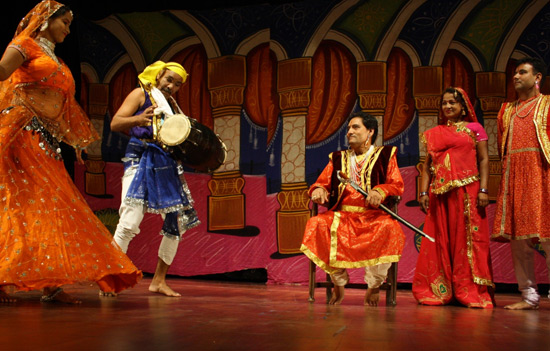
As the
name suggests, it is the Nautanki which is prevalent for centuries, enjoying
the popularity of common folks as it combines various stories with music, dance
and dialogues with humour and satire in it.
The
Sangeet Rani Nautanki is the oldest and most popular group with several
presentations to their credit.
To see video of performance 2.30 minutes
2. Mayur dance of Braj
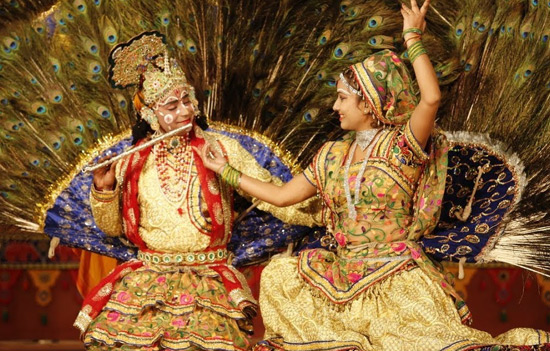
Mayur
dance or the dance of the peacock is performed by two dancers, the peacock and
the peahen, with a variety of movements, signifying the typical characteristics
of the bird and the dance. It is performed on several religious or social
occasions.
To see video of performance 9 minutes
3. Charkula dance
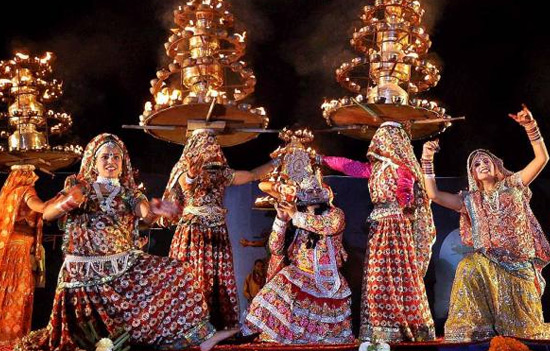
In this
dance, a woman carries a big lamp on her head which has several lamps that burn
while she dances slowly and gracefully. This is a rare spectacle but not an
easy task to dance with weight on her head.
To see video of performance 1 minute
4. Braj Raslila
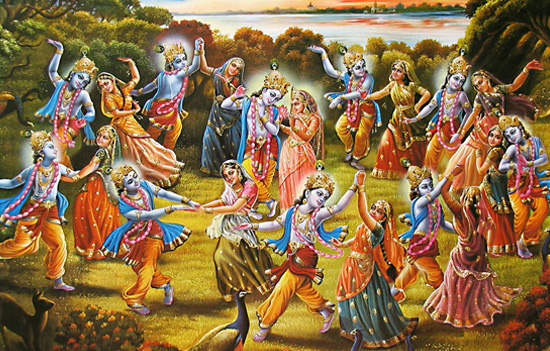
Raslila
is performed in Braj and Vrindavan as a tribute to Lord Krishna. The Ras lila
is performed by Radha and Gopis. This dance is of particular significance as it
is believed that the Maha Raas was performed wherein every Gopi felt that Lord
Krishna is dancing with her.
Hence, it
is a dance of divine love, eternal bliss with the union of the human and divine
soul. This dance is either performed with sticks or while holding each
other and clapping while dancing.
To see video of performance 3 minutes
Also, “Kajri dance is performed by women just before the arrival of monsoon to express joy and happiness.” Source Indian Express
D. Madhya Pradesh and Chhattisgarh
1. Jawara
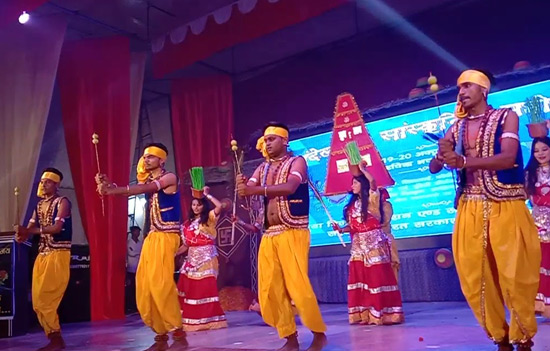
Jawara is
a joyful dance exclusively performed by women, prevailing mainly in the
Bundelkhand region of Madhya Pradesh. Young women rejoice and dance, while
carrying the basket of Jawara on their head. They move in different ways, while
dancing with uniformity and dexterity, reaping the costume and other activities
concerning farming and growing of Jawara.
To see video of performance
10 minutes
3. Tertali
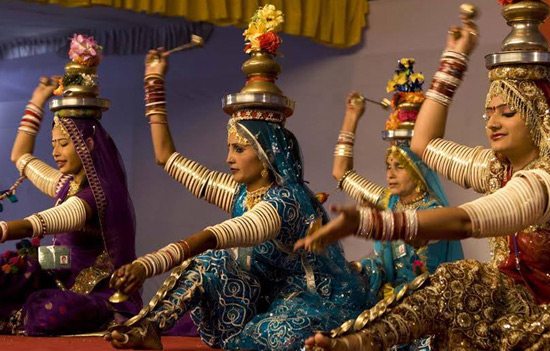
One of
the most popular dances of Madhya Pradesh. It is particularly known for its
rhythmic and musical quality. Tertali literally means 13 talis, referring to the metal cymbals that are tied in different
parts of the body and the two cymbals are held on the hand, while the
music is on. The dancers or musicians, consistently strike on the cymbals all
over the body creating the jingling sound of music which is quite pleasant
to the ears.
Simultaneously
the women also hold a sword in the mouth, while balancing earthen pot
on the head. This act is done in a seated position. This particular musical
exposition attracts a lot of attention.
3. Lehangi
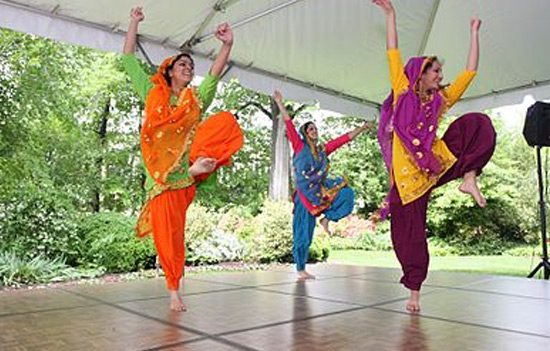
Lehangi
is the dance of the Banjara or Kanjar adivasis. This is particularly performed
at the advent of the monsoon or to celebrate the rainy season. They perform in
different areas and villages, entertaining everyone with their dance. This is
performed by men and women. The men dance with sticks and perform acrobatic
feats too.
To see video of performance
13.5 minutes
4. Akiri
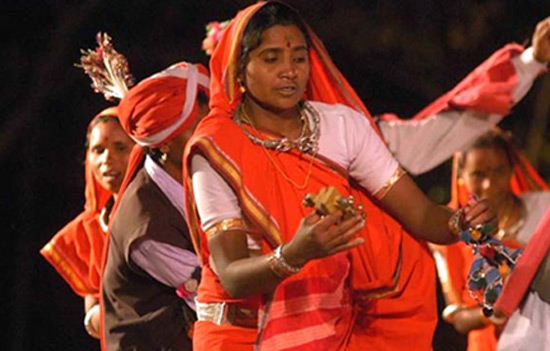
Akiri is performed by the cattle herders of Gwalior. They are considered to be descendants of Sri Krishna. This dance is performed in circular patterns by men by communities like Ahir, Gwala, Rawat, Beat and Baredi. The dance starts on the onset of the festival of lights i.e. Diwali and continues till “Kartik Purnima”. Purpose of dance is for prosperity and well-being of mankind.
5. Gaur, Bastar
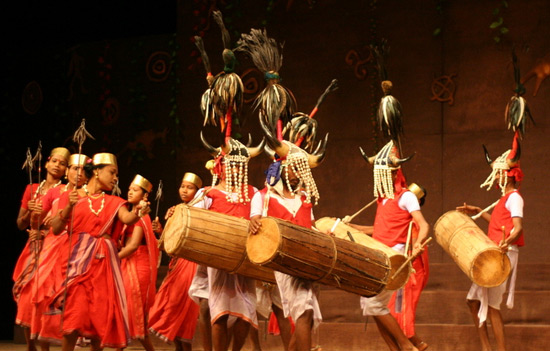
Gaur
literally means the ferocious bison, hence this dance performed by Horn Marias
or Tallaguda Marias of South Bastar region. The dance starts with the music of
the Bamboo trumpet or a horn and the male dancers have a headdress with
stringed cowries and plumes of peacock feathers as they dance to the music of the
flutes and drums. This dance is particularly significant as the different
characteristic moves of the ferocious bison are enacted as they attack and
chase the female dancers. The female dancers are adorned with brass fillets and
bead necklaces and they dance with the sticks known as tirududi.
To see album
of performance during Bastar Dussehra
To see video of performance
SUPERB 2.5 minutes
To see video of folk dance
Badhai 10 minutes
To see video on folk dance
of MP 11 minutes
E. Bihar
1. Jhijhiya
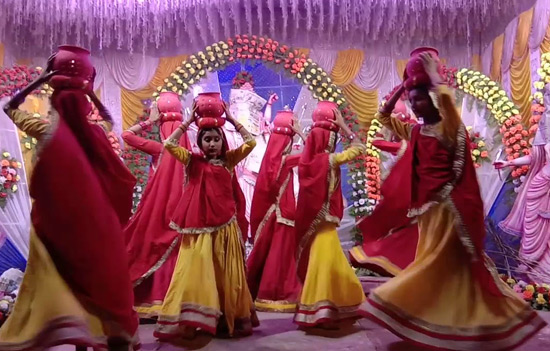
Jhijhiya
is a religious dance performed by women and assisted by men. It is performed
as a devotion to the goddess during Navaratri. The dancers are attired in long
skirts and colourful cholis (blouse) dance with earthen or brass pots on
their head, while offering their prayers to goddess Lakshmi, Parvati and
Saraswati.
The men
assist in the religious proceedings with the burning lamps along with mango
leaves to ward off the evil and for a peaceful and healthy living in society.
The dancers move in circular patterns, while the prayers are being offered.
To see video of performance
3.49 minutes
“Paika is a warrior dance performed with
a shield and sword. Bidesia dance is
a popular dance drama performed in the Bhojpuri-speaking belt of Bihar. The
topics dealt with are mainly contradictory in nature-like tradition and
modernity, urban-rural divide, rich and poor etc. Female parts are performed by
male actor-dancers. The Jat-Jatin dance is performed as a duet and deals with socially and emotionally charged topics.” Source
Indian Express
F. Rajasthan
1. Ghoomar
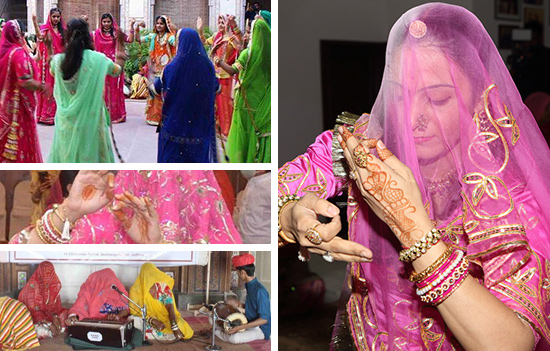
One of
the most popular folk dance of Rajasthan is Ghoomar which means to rotate,
hence the dance is quite exciting and a visual treat as the dancers attired in
colourful and bright coloured long skirts start with slow and graceful
movements and culminating in fast tempo, drawn from the classical dance kathak
which is known for its spins and circular movements.
This
dance is performed on several occasions, religious and social for e.g. the
arrival of the newly wed bride or during festivals like Holi or Tej.
To read in detail including if u want to learn Ghoomar:
An elegant dance form of Rajasthan
To see video of performance
4.42 minutes
2. Bhavai
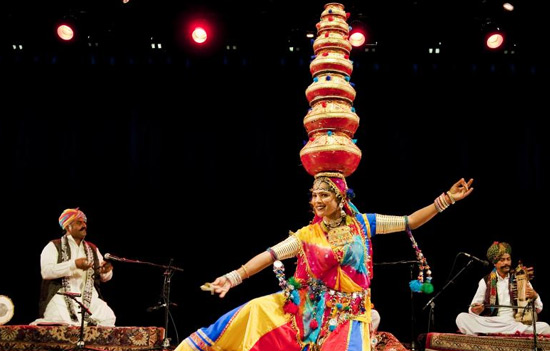
Another
popular folk dance of Rajasthan which has ritualistic significance, is performed
by the Kabelia, Meena, Bhil or the Kumhar Adivasi communities. The women
balance on the perimeter of the brass plate or on the top of a glass and dance
various steps as part of the ritual and as an offering to the divine spirit.
The males sing, play the harmonium, sarangi and the dholak.
To see video of performance
1.32 minutes
3. Kachhi Ghodi
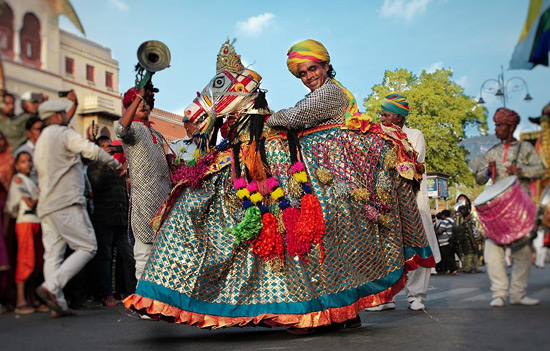
As the
name suggests Kachchi means tender or not ripe and Ghodi refers to the female
horse, hence this is dance of the male and female horse, prevalent in the
Shekhawat region of Rajasthan. Men appear with the props of the decorated
horse along with the female. This is a playful dance of horse moves and jumps,
also considered a dance depicting bravery and chivalry.
To see video of performance
2.32 minutes
4. Gair
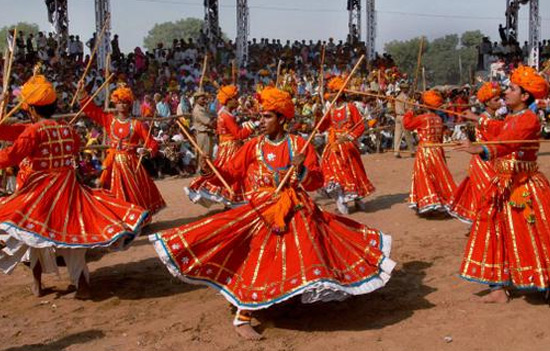
Gair is a
dance performed by men and women of the Bhil community during religious
occasions like Janmastami or social occasions like the Holi festival. Men dance
with sticks and swords as they move and dance in clockwise and anti-clockwise
movements
To see video of performance
6.27 minutes Fun to watch
5. Chari
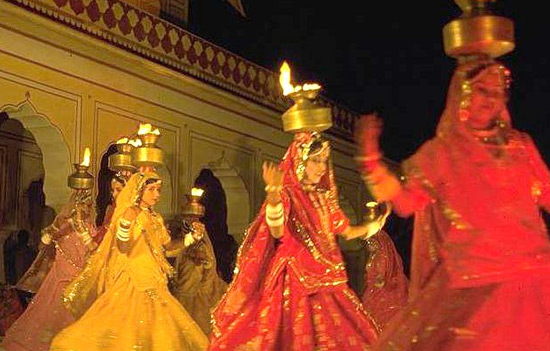
Chari is
a ritual dance. It is performed as part of the ritual by the Saini community of
Ajmer and Gujjars of Kishnagad. This dance is also performed on the occasion of
the birth of a male child. Women dance with Chari (pot) on the head with a
lighted lamp on it as an offering for divine intervention. This dance is
performed to the music of dholak, Harmonium and Nagada.
Also, “Chari is performed by villagers to celebrate the discovery of
water in the desert state. It is performed by women balancing brass pots on
their heads. Kalbeliya is performed
by the snake charmer-community of Rajasthan. In Bhawai, women dance while simultaneously balancing 8-9 pitchers on their heads.” Source Indian Express
G. Himachal Pradesh
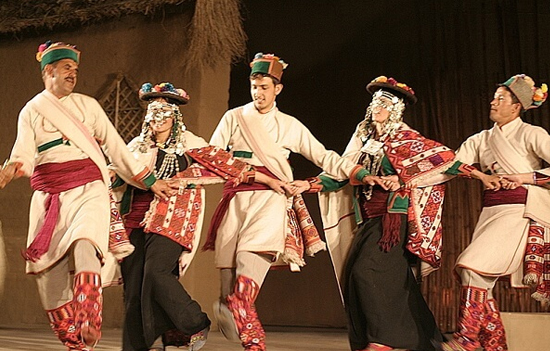 Nati
Nati
Nati is the
most popular dance i.e. also performed at various festivals. It has various
forms depending on region. “It starts at a slow speed, while doing this it is called loose pulse and later it increases at a rapid pace. Dholak, Karnal, Ranasingha, Flute, Shehnai, and Nagade are used in this dance.” Source
2. Channak Chaam Dance
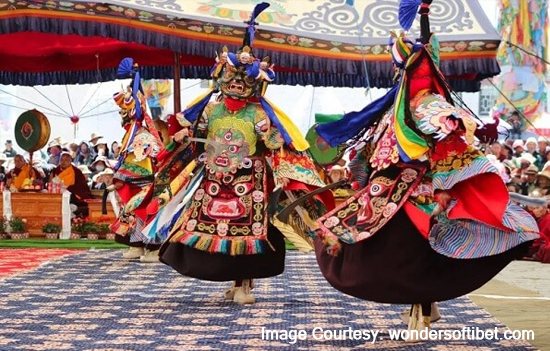
“Chhanak Chham dance is very famous dance form of Himachal Pradesh in the Lahaul-Spiti region, in the memory of Lord Buddha and as a tribute! The Lamas of the Lahaul-Spiti region perform this devotional dance on the occasion of Chakhar, which happens once every three years! It is famous for its vibrant hats, costumes, and masks. The theme of his costume is yellow, black, and gold and is designed to be sleek and shiny.” Source
3. Rakshasa Dance
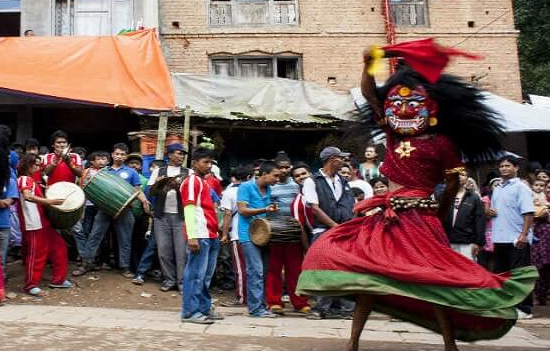
“Rakshasa dance is related to the Kinnaur district of Himachal Pradesh. Rakshasa dance is performed wearing demon masks. These masks are in the numbers three, five, seven, and nine. This dance perform to protect crops from evil spirits and demons in this region.” Source
4. Dangi Dance
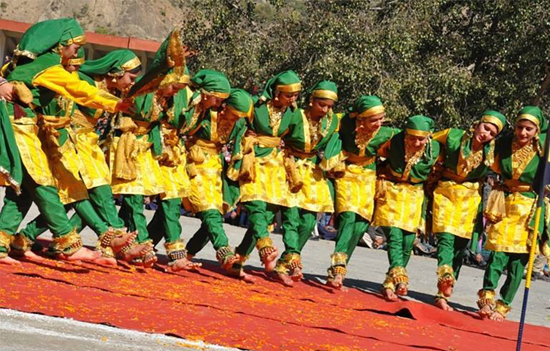
“Another popular dance form of Himachal Pradesh is Dangi. It is predominantly performed by female dancers, wearing traditional dresses, holding hands to form a semi-circle, and dancing with their lower bodies. This dance takes place at Naina Devi’s Temple as a symbol of their devotion.” Source
“Folk dances of Himachal Pradesh depict the population's closeness to nature. Mala dance is performed by people
weaving their hands together in an intricate pattern resembling a garland.
Chhambha similar to
Bhangra-is performed by wearing elaborate masks and replicates tales of demons
being chased away by good forces after destroying crops.
Cholamba is performed in the Ropa valley when a tiger is killed — is characterised by formations in which the group of dancers looks like a coiled serpent. In the Nuala dance form, a garland is placed around Lord Shiva and the dance takes place around the idol.
Jhoori has questions and
answers danced to a rhythm, with each sentence ending with a cry of Hoo Hoo.
In
Dhadhair, dancers dance with weapons
and charge towards imaginary adversaries.
Kaydayat is characterised by marvellous sword play which becomes more vigorous with the rise of the tempo.” Source Indian Express
Also read 10
Folk Dances of Himachal Pradesh N Here
N Festivals
of Himachal Pradesh
To
see pictures of Classical and Folk Dances of India
Also read
1.
Folk
dances of South India
2.
Folk
dances of Odisha
3.
Kalbelia
folk dance of Rajasthan
4.
Adivasi
dances of India
5.
Folk
dance forms of Assam
6.
Folk
dance performances at Shilp Gram Udaipur